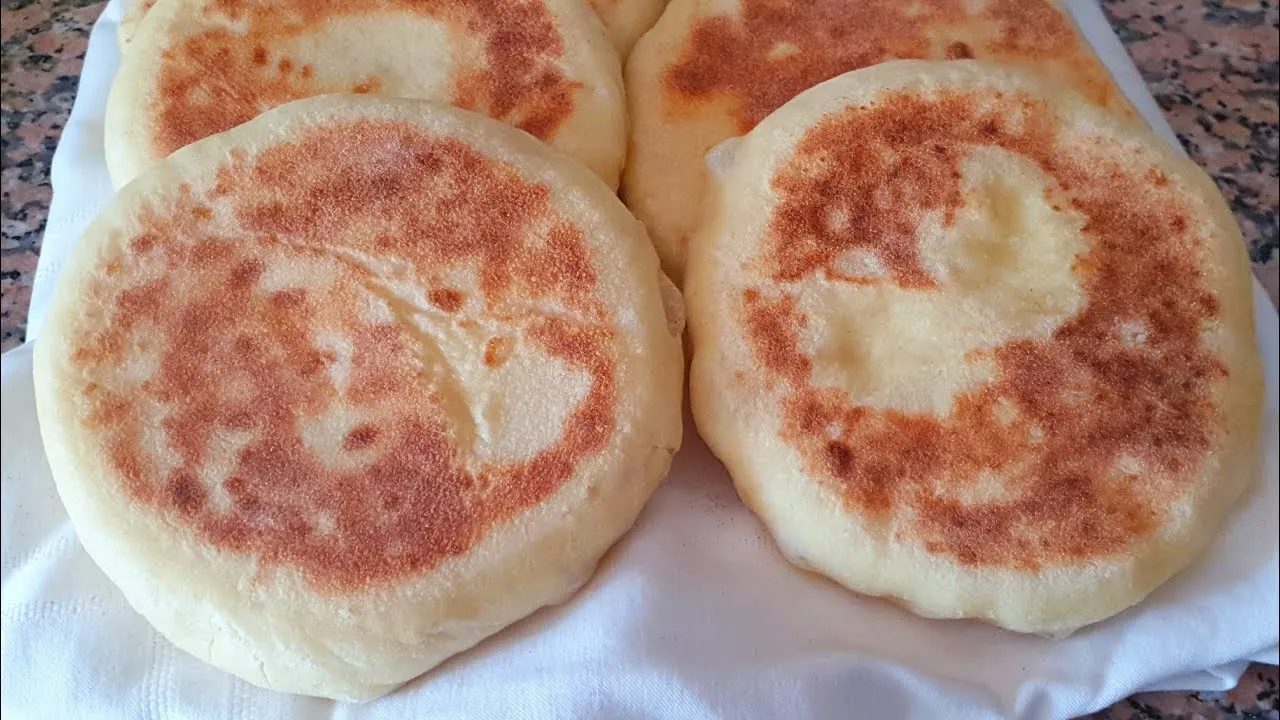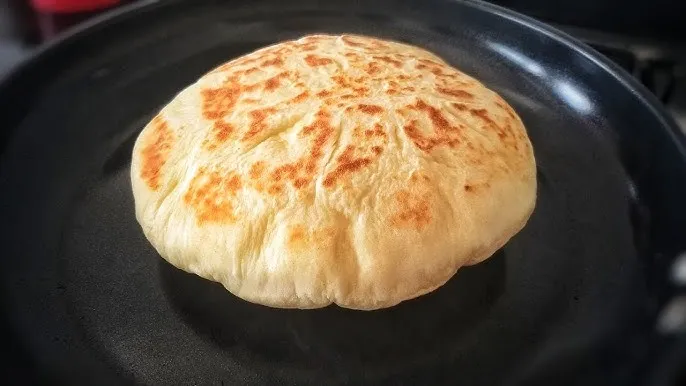 Save
Save
This traditional Moroccan Batbout recipe creates pillowy, skillet-cooked flatbreads that puff beautifully when cooked. Perfect for scooping up tagines or enjoying with honey and butter, these bread pockets have been a staple in my kitchen since learning the technique from a Moroccan friend who insisted proper batbout should always puff up completely.
I first made these during a power outage when I couldn't use my oven, and my family was amazed at how these skillet breads puffed up like magic. Now my children request them weekly, calling them "pocket breads" because they love stuffing them with their favorite fillings.
Ingredients
- All purpose flour provides the perfect structure for these flatbreads
- Whole wheat flour adds nutritional value and a slightly nutty flavor that complements Moroccan dishes
- Active dry yeast gives the signature rise and lightness
- Sugar feeds the yeast and adds subtle sweetness
- Salt enhances flavor and controls fermentation
- Warm water activates the yeast and brings the dough together
Step-by-Step Instructions
- Prepare the Dough
- Whisk together both flours in a large bowl ensuring even distribution. Add the yeast, sugar, and salt, mixing well to incorporate everything evenly. Gradually add warm water while mixing with your hands or a wooden spoon. The dough should come together and feel tacky but not sticky. If too dry, add a tablespoon of water at a time. If too wet, add a sprinkle of flour. Knead the dough thoroughly for a full 15 minutes until it becomes smooth and elastic. This develops the gluten structure needed for the batbout to puff properly.
- First Rise
- Place the dough in a lightly oiled bowl and cover with a damp kitchen towel. Set it in a warm, draft free spot in your kitchen. Allow the dough to rise until doubled in size, approximately one hour. The dough should look puffy and feel light when gently poked.
- Shape the Batbout
- Gently deflate the risen dough and transfer to a clean work surface with minimal flour dusting. Divide the dough into 12 equal portions using a bench scraper or knife. Roll each piece into a smooth ball by cupping your hand over it and moving in circular motions. Flatten each ball into a disc about 1/2 inch thick using your fingertips first, then a rolling pin. Aim for uniform thickness throughout to ensure even cooking.
- Final Rest and Cooking
- Arrange the shaped discs on a lightly floured surface and cover with a clean cloth. Allow them to rest for 20 minutes this short second rise makes them extra tender. Heat a dry cast iron skillet or heavy pan over medium heat until hot but not smoking. Place a batbout disc in the pan and cook for 2 minutes until small bubbles form on the surface. Flip and cook for another 2 minutes until the bread puffs up dramatically. Flip once more to ensure both sides are golden brown with characteristic dark spots.
 Save
Save
My favorite part of making batbout is watching the dramatic puffing that happens during cooking. My grandmother always said the bread's ability to puff represented good luck in the kitchen. The first time my daughter saw it happen, she squealed with delight and declared it "bread magic."
Storage and Freshness
Batbout bread stays remarkably fresh when stored properly. After cooling completely, store the flatbreads in a sealed plastic bag or airtight container at room temperature for up to 3 days. For longer storage, freeze them individually wrapped in plastic, then placed in a freezer bag for up to 3 months. To refresh before serving, lightly dampen the surface with a sprinkle of water and warm in a skillet for 30 seconds per side. This reactivates the soft texture without drying out the bread.
Cultural Significance
In Morocco, batbout (sometimes called mkhamer or toghrift in different regions) represents both everyday sustenance and celebration food. Traditionally cooked by women on stovetop clay plates called "tawa," these breads were perfect for nomadic lifestyles before modern ovens. During Ramadan, batbout frequently appears on iftar tables, stuffed with spiced meats or vegetables for a satisfying meal after the day's fast. Making batbout represents a connection to centuries of Moroccan culinary tradition passed through generations.
Serving Suggestions
Transform your batbout into a complete meal with various serving styles. Split them open to create pockets for sandwich fillings like grilled meats, fresh vegetables, and herbed yogurt sauce. For breakfast, serve warm with honey, soft cheese, and mint tea in true Moroccan fashion. They pair wonderfully with hearty tagines, allowing you to scoop up rich sauces. For an impressive appetizer, cut into triangles and serve alongside hummus, baba ganoush, or muhammara for dipping. The subtle flavor of batbout makes it versatile enough to complement both Mediterranean and Middle Eastern flavor profiles.
Troubleshooting Tips
If your batbout isn't puffing properly, the dough may be too thick or the pan not hot enough. Make sure your dough is rolled to uniform thickness and your pan is thoroughly preheated. Watch for small bubbles forming on the surface as your indicator to flip. If the bread burns before puffing, your heat is too high. Finding the perfect temperature balance takes practice but delivers spectacular results.
Recipe FAQs
- → What is the difference between Batbout and Mkhamar?
Batbout and Mkhamar are essentially the same bread, just with regional name variations in Morocco. Both refer to a stovetop flatbread that puffs during cooking, creating a pocket. Some regions may have slight variations in thickness or size, but the cooking method and basic ingredients remain consistent throughout Morocco.
- → Can I make Batbout without whole wheat flour?
Yes, you can make Batbout using only white all-purpose flour. The whole wheat flour is optional and primarily adds a softer texture and slightly nuttier flavor. For a traditional white Batbout, simply use 600g of all-purpose flour instead of the flour combination in the recipe.
- → Why isn't my Batbout puffing up properly?
Several factors could prevent proper puffing: your pan might not be hot enough, the dough may be too thick or uneven, or you might have used too much flour during shaping which prevents proper sealing. Make sure your pan is thoroughly heated before adding the dough, maintain even thickness when shaping, and avoid over-flouring your work surface.
- → How do I store leftover Batbout?
Once completely cooled, store Batbout in an airtight container or plastic bag at room temperature for up to 2 days. For longer storage, freeze for up to 1 month. To refresh before eating, lightly sprinkle with water and warm in a pan or microwave until soft and pliable again.
- → What dishes pair well with Moroccan Batbout?
Batbout pairs beautifully with Moroccan tagines, stews, and dips like hummus or baba ganoush. It's commonly used to scoop up food instead of using utensils. It also makes an excellent sandwich bread - try filling it with grilled meats, vegetables, or traditional Moroccan fillings like kefta (spiced ground meat) or preserved lemon chicken.
- → Can I add herbs or spices to the dough?
Absolutely! While traditional Batbout is plain, you can customize it by adding herbs like fresh mint, parsley, or spices such as cumin, paprika, or za'atar to the dry ingredients. For a more aromatic version, try adding a teaspoon of anise seeds or a pinch of saffron dissolved in the warm water before mixing into the dough.
